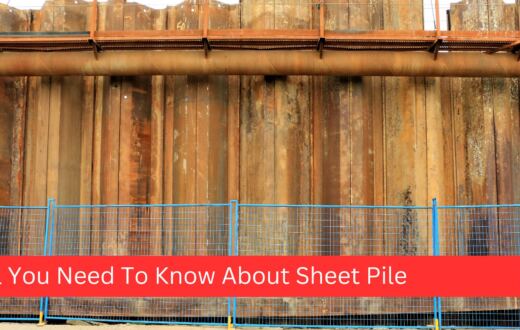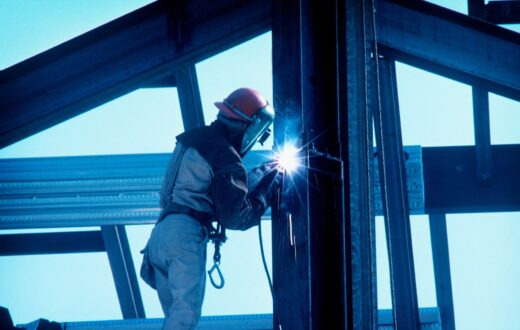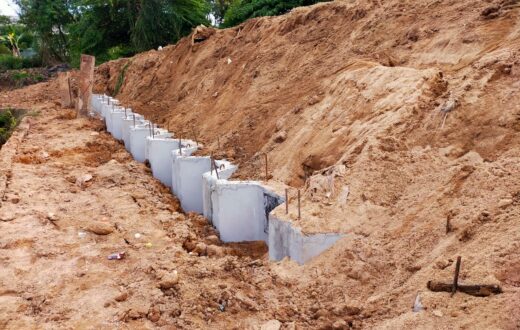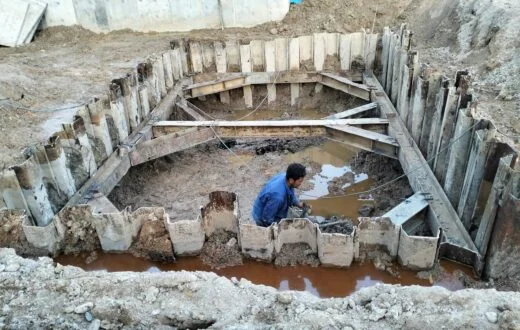Steel sheet pile and concrete sheet pile are two commonly used materials in construction projects, particularly in foundation and waterfront structures. Both materials have their advantages and disadvantages, and choosing the right one depends on various factors. In this article, we will compare steel sheet pile and concrete sheet pile to help you understand their differences and make an informed decision.
1. Introduction
Sheet piles are long, interlocking sections of materials used to create retaining walls, cofferdams, and bulkheads. They are installed vertically into the ground to provide structural support and prevent soil erosion. Steel sheet pile and concrete sheet pile are two popular options for such applications due to their strength and durability.
2. Definition of Sheet Piles
Sheet piles are typically made of steel or concrete and come in various shapes and sizes. They are designed to withstand lateral forces and provide stability to structures in areas with poor soil conditions or high water pressure.
3. Characteristics of Steel Sheet Pile
Steel sheet pile is made of high-strength steel and consists of individual sections that interlock together. It is available in different profiles, such as U-shaped, Z-shaped, or straight, depending on the project requirements. Steel sheet pile is known for its excellent strength-to-weight ratio, allowing for efficient installation and removal.
4. Advantages of Steel Sheet Pile
- High strength: Steel sheet pile offers exceptional strength and rigidity, making it suitable for projects requiring deep excavations or tall retaining walls.
- Versatility: Steel sheet pile can be used in a wide range of soil and water conditions, including soft soils, hard soils, and marine environments.
- Durability: Steel sheet pile is resistant to corrosion and can withstand harsh weather conditions, making it a long-lasting solution.
- Easy installation and removal: Steel sheet pile can be quickly installed using methods like driving or vibrating. It also allows for easy extraction if needed.
- Recyclability: Steel sheet pile is recyclable, making it an environmentally friendly choice.
5. Disadvantages of Steel Sheet Pile
- Susceptible to corrosion: While steel sheet pile is generally resistant to corrosion, it may require additional protective measures in aggressive environments to ensure its longevity.
- Higher initial cost: Steel sheet pile tends to have a higher upfront cost compared to concrete sheet pile.
- Noise and vibration during installation: The installation process of steel sheet pile may generate noise and vibrations, which can be a concern in certain areas.
6. Characteristics of Concrete Sheet Pile
Concrete sheet pile is made of reinforced concrete and comes in various shapes, including U-shaped and L-shaped profiles. It offers excellent structural integrity and is commonly used in marine and waterfront applications.
7. Advantages of Concrete Sheet Pile
Concrete sheet pile offers several advantages in construction projects:
- Durability: Concrete sheet pile is highly durable and can withstand the elements, including harsh weather conditions, without deteriorating. It is resistant to corrosion, making it suitable for long-term applications in marine environments.
- Versatility: Concrete sheet pile is compatible with various soil conditions and can be used in both temporary and permanent structures. It can be designed to handle high loads and is commonly used in waterfront projects, such as marine structures and ports.
- Environmental friendliness: Concrete sheet pile is an eco-friendly option as it is made from natural materials, such as cement, aggregates, and water. It has a minimal environmental impact and can be recycled at the end of its service life.
- Sound insulation: Concrete sheet pile has excellent sound insulation properties, which can be beneficial in noise-sensitive areas or projects near residential zones.
- Resistance to marine borers: In marine environments, concrete sheet pile offers resistance to marine borers and other organisms that can cause damage to structures. This makes it a reliable choice for coastal and offshore applications.
8. Disadvantages of Concrete Sheet Pile
While concrete sheet pile has several advantages, it also has some limitations:
- Weight: Concrete sheet pile is heavier compared to steel sheet pile, which can make handling and installation more challenging. Specialized equipment may be required for lifting and positioning the heavy concrete sections.
- Limited interlock strength: The interlocking strength of concrete sheet pile is generally lower than that of steel sheet pile. This can affect the overall stability and load-bearing capacity of the structure, especially in softer soils or when dealing with high water pressure.
- Higher initial cost: Concrete sheet pile tends to have a higher upfront cost compared to steel sheet pile due to the materials and labor involved in its production and installation. However, it offers long-term durability, which can offset the initial investment.
- Limited flexibility: Concrete sheet pile is not as flexible as steel sheet pile, which can limit its adaptability to certain construction requirements. Modifications or adjustments to the pile may be more challenging and time-consuming.
9. Comparison of Steel Sheet Pile and Concrete Sheet Pile
When comparing steel sheet pile and concrete sheet pile, it’s important to consider the specific project requirements, soil conditions, budget constraints, and other relevant factors. Here are some key points of comparison:
- Strength and load-bearing capacity: Steel sheet pile generally has higher strength and load-bearing capacity compared to concrete sheet pile. It is well-suited for projects that require deep excavations or tall retaining walls.
- Installation and removal: Steel sheet pile can be easily installed and removed using methods like driving or vibrating. Concrete sheet pile, on the other hand, may require more complex installation techniques and specialized equipment.
- Durability and maintenance: Steel sheet pile is resistant to corrosion but may require additional measures in aggressive environments. Concrete sheet pile has inherent corrosion resistance and requires minimal maintenance.
- Flexibility and adaptability: Steel sheet pile offers more flexibility and adaptability, allowing for modifications and adjustments during the construction process. Concrete sheet pile is less flexible but provides stability and is suitable for long-term applications.
- Cost considerations: Steel sheet pile generally has a lower initial cost compared to concrete sheet pile. However, the long-term durability and lower maintenance requirements of concrete sheet pile can offset the initial investment.
It’s important to consult with a qualified engineer or construction professional to determine the most suitable sheet pile material for your specific project.
10. Factors to Consider in Choosing Sheet Piles
When deciding between steel sheet pile and concrete sheet pile, several factors should be considered:
- Project requirements: Evaluate the specific needs of the project, including the load-bearing capacity, required lifespan, and expected soil conditions. Each material has its own strengths and weaknesses that may align differently with project requirements.
- Soil conditions: Consider the characteristics of the soil, such as its stability, water content, and compaction. Steel sheet pile is versatile and suitable for various soil conditions, while concrete sheet pile may be more suitable for cohesive or stable soils.
- Water conditions: Assess the water pressure and environmental factors, especially for waterfront projects. Both steel sheet pile and concrete sheet pile can perform well in marine environments, but concrete sheet pile’s inherent resistance to corrosion may make it a preferred choice in aggressive water conditions.
- Installation method: Determine the available equipment, resources, and timeframe for installation. Steel sheet pile can be installed and removed more quickly and efficiently, while concrete sheet pile may require specialized equipment and longer installation times.
- Aesthetics: Consider the visual impact of the sheet pile structure, especially in projects where aesthetics play a significant role. Concrete sheet pile can offer a more uniform appearance and can be designed to match the desired aesthetic requirements.
- Budget considerations: Evaluate the initial cost and long-term maintenance requirements. Steel sheet pile often has a lower initial cost but may require additional corrosion protection. Concrete sheet pile has a higher initial cost but offers long-term durability and minimal maintenance.
By carefully considering these factors, you can make an informed decision on whether to choose steel sheet pile or concrete sheet pile for your specific project.
11. Case Studies
To further illustrate the applications of steel sheet pile and concrete sheet pile, let’s take a look at two case studies:
Case Study 1: Waterfront Project
In a waterfront project where the primary focus is on stability and long-term durability, concrete sheet pile may be the preferred choice. Its resistance to corrosion and ability to withstand high water pressure make it suitable for structures such as seawalls and bulkheads.
Case Study 2: Deep Excavation Project
For a project that involves deep excavations and requires efficient installation and removal, steel sheet pile can offer advantages. Its high strength-to-weight ratio allows for easier handling and faster installation, making it a practical choice for temporary shoring systems or cofferdams.
These case studies demonstrate how the selection of sheet pile materials depends on the specific project requirements and conditions.
12. Environmental Impact
Both steel sheet pile and concrete sheet pile have environmental considerations to keep in mind:
- Steel sheet pile: While steel sheet pile is recyclable and can be reused, its production requires energy and raw materials. Additionally, the corrosion protection coatings used on steel sheet pile may have an impact on the environment if not properly handled.
- Concrete sheet pile: Concrete sheet pile is made from natural materials, such as cement and aggregates. It has a lower carbon footprint compared to steel production. Concrete sheet pile can also be recycled at the end of its service life, reducing its impact on the environment.
It’s essential to implement proper waste management and recycling practices during construction and demolition to minimize the environmental impact of sheet pile materials.
13. Cost Considerations
When it comes to cost considerations, several factors come into play:
- Initial cost: Steel sheet pile generally has a lower initial cost compared to concrete sheet pile. However, this may vary depending on the specific project requirements and market conditions.
- Long-term maintenance: Concrete sheet pile has a longer lifespan and requires minimal maintenance, resulting in potential cost savings over its service life. Steel sheet pile may require additional measures, such as corrosion protection coatings, which can add to the long-term maintenance costs.
- Installation and removal costs: The installation and removal methods of steel sheet pile and concrete sheet pile can impact the overall cost of the project. Steel sheet pile is generally easier and faster to install and remove, potentially reducing labor costs.
- Project duration: The duration of the project should be taken into account when considering the cost. Concrete sheet pile’s durability and resistance to environmental factors can make it a cost-effective choice for long-term projects.
It’s crucial to evaluate the specific cost factors relevant to your project and consider the long-term benefits and maintenance requirements when selecting between steel sheet pile and concrete sheet pile.
14. Conclusion
Steel sheet pile and concrete sheet pile are both valuable options for construction projects requiring structural support and soil retention. While steel sheet pile offers versatility, ease of installation, and high strength, concrete sheet pile provides durability, resistance to corrosion, and long-term stability. Choosing between the two materials depends on factors such as project requirements, soil and water conditions, installation methods, aesthetics, budget considerations, and environmental impact.
Careful evaluation of these factors and consulting with experts can help you make an informed decision that aligns with your project goals and requirements. Remember to prioritize factors such as load-bearing capacity, site-specific conditions, project duration, and overall cost considerations.
15. Frequently Asked Questions (FAQs)
- Which sheet pile material is more cost-effective? The cost-effectiveness of steel sheet pile or concrete sheet pile depends on the specific project requirements and factors such as installation methods, maintenance, and project duration. Assessing these factors will help determine the most cost-effective solution for your project.
- Can steel sheet pile be used in marine environments? Yes, steel sheet pile can be used in marine environments. However, additional measures such as corrosion protection coatings may be required to ensure its longevity and performance in aggressive water conditions.
- Is concrete sheet pile suitable for deep excavations? Concrete sheet pile is suitable for various applications, including deep excavations. Its inherent strength and durability make it a reliable choice for projects that require deep retaining walls or structures.
- Which sheet pile material has a longer lifespan? Both steel sheet pile and concrete sheet pile can have long lifespans when properly designed, installed, and maintained. Concrete sheet pile’s resistance to corrosion gives it an advantage in terms of long-term durability.
- Can sheet piles be recycled? Yes, both steel sheet pile and concrete sheet pile can be recycled at the end of their service life. Proper recycling and waste management practices should be implemented to minimize the environmental impact.
Author

Chee How is a seasoned professional in the construction and civil engineering industry with over 11 years of experience. Specializing in sheet piling solutions, Chee How brings a wealth of knowledge on sustainable building practices, innovative engineering techniques, and industry trends. As a dedicated expert at Hai Fu Sheet Piles Sdn Bhd, Chee How is committed to providing practical insights and expert advice to help professionals achieve their project goals with efficiency and precision. Outside of work, Chee How enjoys reading and basketball, reflecting a passion for both professional and personal growth.
View all posts







